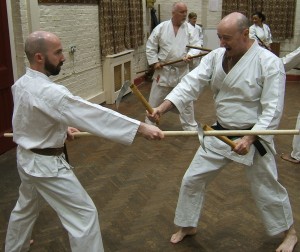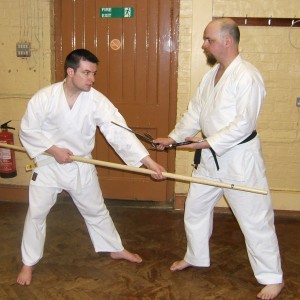Kobudo Information
Itotsu(Sometimes pronounced Itosu) ryu Kobudo is a traditional kobudo style which utilises many Okinawan weapons. At its core are the nunchaku which are the first weapon that most people come across in Ryukyu Kobudo. The style that I do is traditional Itotsu ryu which bears little resemblance to the flash ‘Bruce Lee’ style of ‘showy’ nunchaku which is often seen nowadays at demo’s and on television. In traditional nunchaku there is no bouncing the weapon off your private parts or passing the weapon between your legs! I have seen demonstrations where exponents hang the weapon round their necks-an instant invitation to strangulation; and have witnessed people throw the weapon high into the air. It is hard to imagine a situation where an Okinawan farmer would, when facing down some armed brigands, throw a perfectly good weapon up into the air! There is a place for this type of training, but it should not be confused with the martial art from which it developed.
The nunchaku developed in Okinawa and there are a number of explanations for their development. The most common one is that they developed from the longer ‘rice-flails’ common throughout South East Asia, and that the fighting version of the flail would be hung along side the innocent flails. The second is that they developed from the wooden clappers used in schools, agriculture, and martial arts. The third is that they were hung alongside the wooden blocks used as a primitive form of fire alarm. The final explanation is that they developed from the wooden horse bridal found in Okinawa and Japan. All of these are plausible explanations, and all have the common thread of two pieces of wood tied with cord being concealed amongst innocent farming implements.
Traditional nunchaku should be joined with strong cord and be fourteen inches long. There are a number of schools which used chained nunchaku, but they are in the minority for a number of reasons. Iron ore was not widely available for the construction of chains two hundred years ago on Okinawa. For the nunchaku to be hung alongside farming implements chain would have stood out. Cord is much safer to train with as it generally frays through gradually so the student gets some warning prior to it snapping, whereas chain can suddenly break-leading to accidents.
Many of the Okinawan weapons were used against brigands and the like, but historically they were also used against sword armed samurai. If you imagine a swordsman standing in front of you it becomes clear that in order for you to strike his right hand you need to be using long fourteen inch nunchaku gripped at the end. I often see non traditionalists gripping the nunchaku near the centre for speed twirling, but in traditional styles the weapon is always gripped at the end and usually with the pinky at the base. The cord should be tied at the side and there should be adequate length to circle a bo(rokushakubo or staff). If the cord is too short when you trap a bo, the end of the nunchaku can break due to the pressure.
The core weapons are the nunchaku, the bo, the sai, the tonfa (like side handled batons), and the kama. The students start with the nunchaku, bo, and the sai. Classes are taught in a manner that includes basic training, kata (sequences), and pair-forms or pre-arranged sparring. The emphasis is on traditional training being used as a tool to build the individual, with no thought being given to competition.




